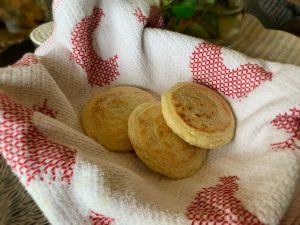By: Michelle Young, News Editor
Arepas y café con leche is a typical Venezuelan breakfast. Arepas are made from pre-cooked corn flour, water, and salt. As a staple food that can substitute for bread, they can be stuffed with almost anything you want. But they’re delicious when accompanied with plain butter, too.
Making them is extremely easy, and there’s a variety of ways to do so. Plus, they’re gluten-free! For beginners without an arepa machine, I suggest frying them, though you can also bake them. The only thing you’ll probably have to go out and buy is harina pan — the corn flour — which you can find at any Latin grocery store.
Regular cornmeal will not work, because it won’t absorb the water to make dough. There is white harina pan and yellow harina pan. The one you use typically comes down to personal preference. The white flour is often softer, and the yellow is usually crispier and saltier.
To make arepas:
For eight arepas, put about two cups of harina pan in a large bowl. The bowl should be large enough to fit both your hands.
Add around 2½ cups of water.
Add a pinch of salt.
Mix all ingredients together until it forms a kind of dough (the harina pan will absorb the water fairly quickly). Use your hands to squish it together — once mixed properly, the dough should be somewhat moist but not sticky.
You should now have a large ball of dough. Break it up into smaller, round pieces, and flatten these. Once flat, grease the pan over medium heat and fry them for about five minutes on each side. Now, you should have crisp dough patties — arepas.
Let them cool off for a few minutes, and then split the patties horizontally. Now, you have a bundle of arepas made with care! Add whatever fillings you would like inside.

Typically, my family has arepas for breakfast, but they can also be served for lunch and dinner. My mom usually has her arepas with ham, cheese, and butter, while I have mine with plain butter. If we’re feeling fancy though, we’ll have reina pepiada and fill the arepas with avocado and chicken.
Food is often tied to culture and family, and arepas have definitely shaped my identity. My mom would often fry tiny ones for my elementary school lunches, bringing many stares from fellow classmates who asked me what I was eating. While the attention was unwanted, and at first made me feel out of place, it was a way to share a piece of me with others.
Some days, I do get tired of eating arepas, but I never tire of watching someone eat it for the first time. Seeing their reaction to something that is so familiar to me, yet new to them, is always gratifying. Having my friends ask me if we were going to eat arepas at my house made me rush to request them from my mom.
Arepas will always be in my heart as a part of family meals and shared cultural traditions. Though, it extends beyond that. It’s a way to bring my culture with me and to bring memories together with the people I love, regardless of our diverse backgrounds and experiences.